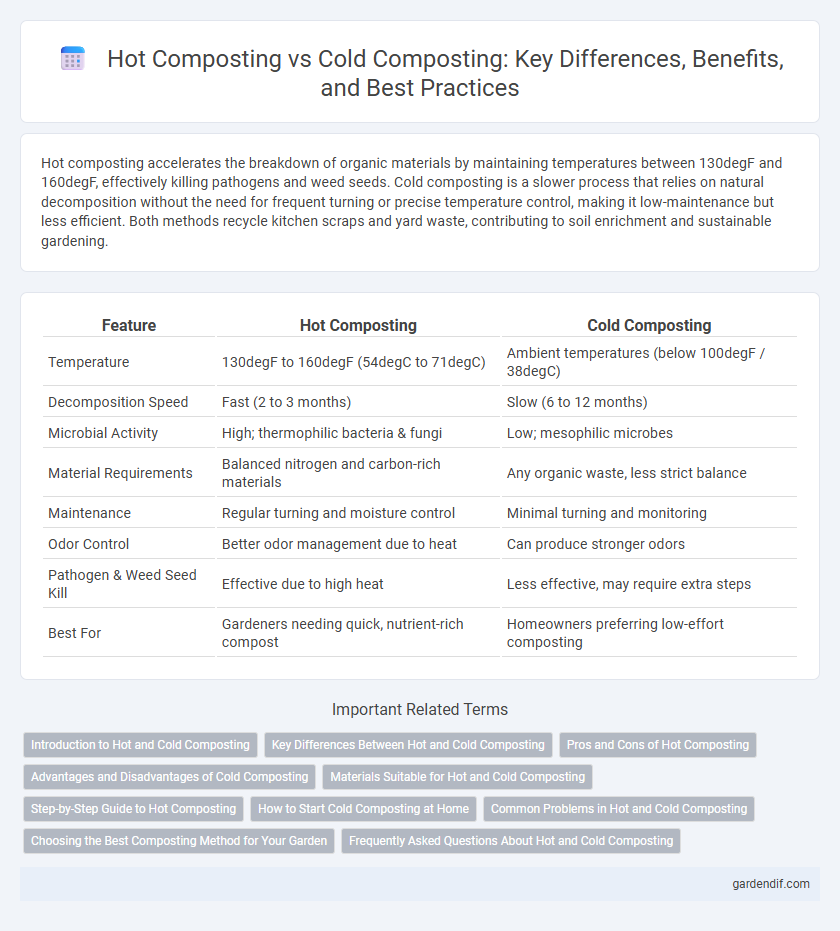
Hot composting vs Cold composting Illustration
Hot composting accelerates the breakdown of organic materials by maintaining temperatures between 130degF and 160degF, effectively killing pathogens and weed seeds. Cold composting is a slower process that relies on natural decomposition without the need for frequent turning or precise temperature control, making it low-maintenance but less efficient. Both methods recycle kitchen scraps and yard waste, contributing to soil enrichment and sustainable gardening.
Table of Comparison
| Feature | Hot Composting | Cold Composting |
|---|---|---|
| Temperature | 130degF to 160degF (54degC to 71degC) | Ambient temperatures (below 100degF / 38degC) |
| Decomposition Speed | Fast (2 to 3 months) | Slow (6 to 12 months) |
| Microbial Activity | High; thermophilic bacteria & fungi | Low; mesophilic microbes |
| Material Requirements | Balanced nitrogen and carbon-rich materials | Any organic waste, less strict balance |
| Maintenance | Regular turning and moisture control | Minimal turning and monitoring |
| Odor Control | Better odor management due to heat | Can produce stronger odors |
| Pathogen & Weed Seed Kill | Effective due to high heat | Less effective, may require extra steps |
| Best For | Gardeners needing quick, nutrient-rich compost | Homeowners preferring low-effort composting |
Introduction to Hot and Cold Composting
Hot composting process rapidly breaks down organic materials by maintaining temperatures between 130degF and 160degF, accelerating microbial activity and pathogen destruction. Cold composting involves slower decomposition at ambient temperatures, requiring minimal maintenance but extending the composting timeline to several months or even years. Both methods recycle organic waste into nutrient-rich soil amendments, promoting sustainable gardening and reducing landfill contributions.
Key Differences Between Hot and Cold Composting
Hot composting rapidly breaks down organic materials by maintaining temperatures between 130degF and 160degF, promoting faster decomposition and pathogen elimination. Cold composting occurs at lower temperatures, typically below 90degF, resulting in slower breakdown and requiring less maintenance. Key differences include processing time, temperature control, microbial activity, and the ability to kill weed seeds and pathogens effectively.
Pros and Cons of Hot Composting
Hot composting accelerates organic matter breakdown, reaching temperatures between 130degF and 160degF, which effectively kills weed seeds and pathogens. It requires more frequent turning and a balanced mix of carbon and nitrogen-rich materials to maintain high temperatures, demanding consistent monitoring and active management. The rapid decomposition process produces nutrient-rich compost faster but can consume more energy and water compared to cold composting.
Advantages and Disadvantages of Cold Composting
Cold composting requires minimal effort and maintains a low risk of unpleasant odors, making it convenient for beginners and those with limited time. However, the decomposition process is slow, often taking several months to over a year to produce usable compost, and it may not effectively kill pathogens or weed seeds. This method is best suited for small-scale composting of non-greasy, small-volume kitchen scraps and garden waste.
Materials Suitable for Hot and Cold Composting
Hot composting requires a balanced mix of nitrogen-rich green materials like fresh grass clippings, vegetable scraps, and coffee grounds combined with carbon-rich brown materials such as dried leaves, straw, and cardboard to generate the high temperatures needed for rapid decomposition. Cold composting accepts a wider variety of organic waste but decomposes more slowly, incorporating kitchen scraps, garden residues, and paper products without the strict carbon-to-nitrogen ratio necessary for hot composting. Materials like meat, dairy, and oily substances are generally unsuitable for both methods due to pest attraction and odor issues, while woody materials need to be shredded for hot compost systems to break down efficiently.
Step-by-Step Guide to Hot Composting
Hot composting accelerates organic matter breakdown by maintaining temperatures between 130degF to 160degF, requiring a careful balance of green nitrogen-rich materials and brown carbon-rich materials. Begin by layering 3 to 4 inches of brown materials, then add an equal thickness of green materials, ensuring adequate moisture and aeration through regular turning every 3 to 5 days. This method produces nutrient-rich compost in 2 to 3 weeks, effectively killing weed seeds and pathogens compared to the slower cold composting process.
How to Start Cold Composting at Home
To start cold composting at home, begin by selecting a shaded, well-drained spot and layering kitchen scraps, dry leaves, and garden waste in a compost bin or pile without frequent turning. Maintain a balance of green nitrogen-rich materials and brown carbon-rich materials to promote slow decomposition. Regularly add organic waste and keep the pile moist but not soggy to support microbial activity for effective cold composting.
Common Problems in Hot and Cold Composting
Hot composting often faces issues such as insufficient aeration leading to anaerobic conditions, which cause foul odors and slow decomposition. Cold composting problems typically include slower breakdown of materials and incomplete composting due to lower microbial activity and less frequent turning. Both methods can suffer from imbalance in carbon-to-nitrogen ratios, attracting pests or resulting in poor-quality compost.
Choosing the Best Composting Method for Your Garden
Hot composting accelerates organic matter breakdown by maintaining temperatures between 130degF and 160degF, which kills pathogens and weed seeds while producing nutrient-rich compost in 2 to 3 months. Cold composting requires less effort but takes 6 to 12 months, relying on natural microbial activity without frequent turning or temperature control, making it ideal for low-maintenance gardens. Selecting the best method depends on available time, garden size, and desired composting speed, with hot composting favored for quick results and cold composting suitable for gradual soil enrichment.
Frequently Asked Questions About Hot and Cold Composting
Hot composting rapidly breaks down organic materials by maintaining temperatures between 130degF and 160degF, effectively killing weed seeds and pathogens within weeks. Cold composting involves slower decomposition at ambient temperatures, taking several months but requiring less maintenance and energy input. Frequently asked questions often address the ideal materials, temperature monitoring, moisture levels, and the importance of turning the pile to optimize either hot or cold composting processes.
Hot composting vs Cold composting Infographic

 gardendif.com
gardendif.com